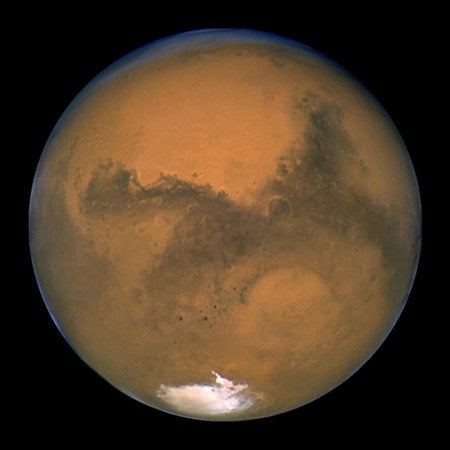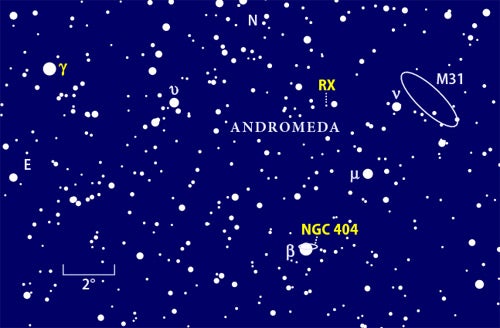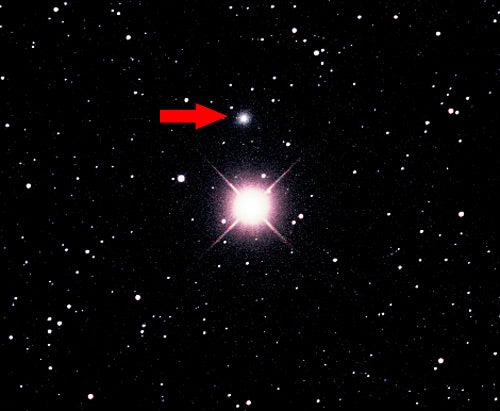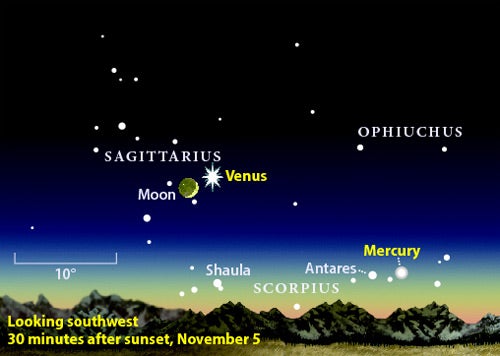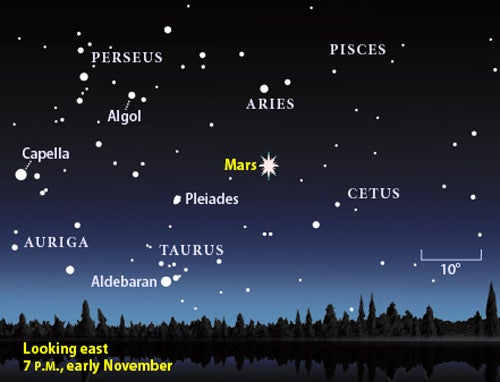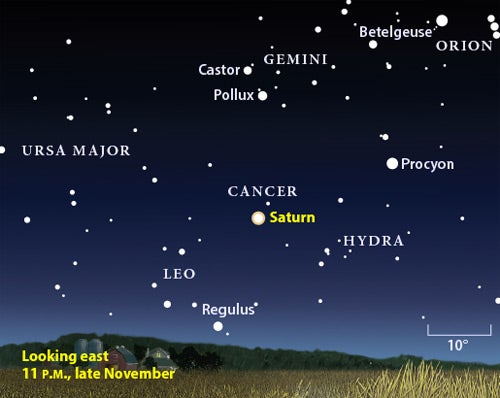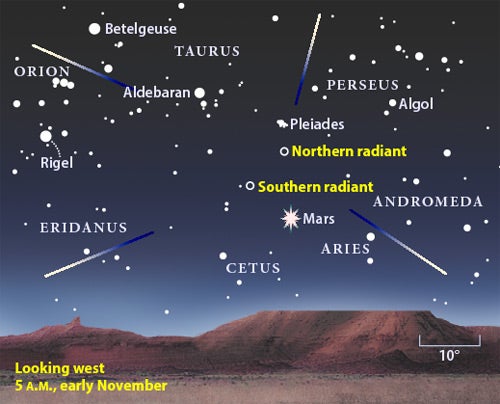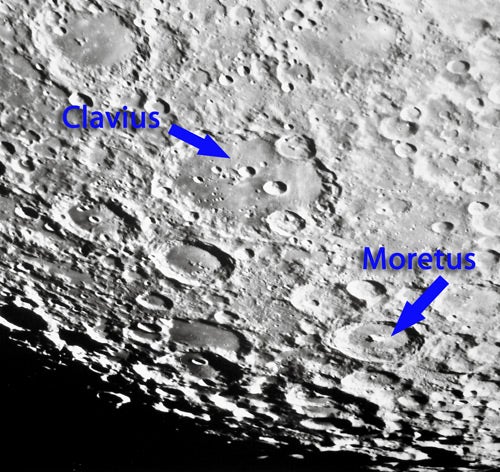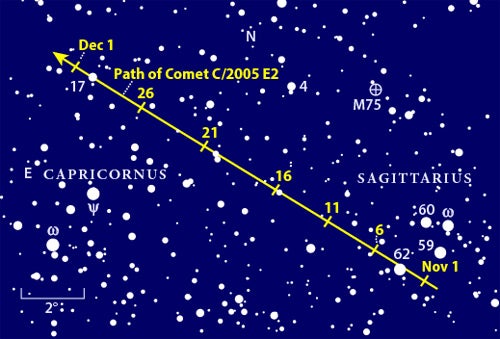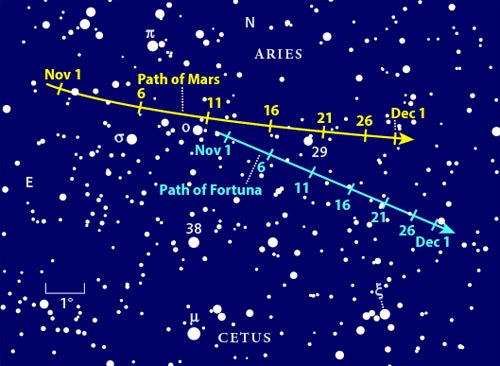Observers in the northern United States, Canada, and Europe probably will see more surface markings now than they did 2 years ago during Mars’ historic apparition, simply because the planet lies much higher in the sky. For more details on Mars’ size and what to look for, see “Set your sights on Mars” on page 76.
A word of advice for beginners: patience. As big as Mars appears compared with an average apparition, newcomers will find its dazzling ochre light a tiny, inscrutable disk. Only dedicated observation will allow your brain to tame the fleeting, low-contrast detail.
If you’ve never seen an asteroid before, Mars presents a nice opportunity by pointing the way to Fortuna. The two aren’t close in space, it’s just that the asteroid lurks in the background along roughly the same line of sight.
Blazing Venus hangs low in the southwest as twilight deepens. This is as high as it’s going to get this year, much lower than it appears during springtime. If you point a small telescope at our sister planet, you will see its phase much as Galileo did almost 400 years ago.
The image resolution is 8 miles (12 kilometers) per pixel. For a labeled version, click here.
If you have a good view of the sky near the true western horizon, try to spy elusive Mercury 30 to 40 minutes after sunset. Scan slowly with binoculars, about four fields of view to the right of Venus.
A razor-thin crescent Moon lies just below Mercury on the 3rd. Follow the innermost planet’s path during the next week as it slides past the sparkling, but fainter, orange star Antares.
Both disappear into the Sun’s glare before mid-November. For lucky observers south of the equator, Venus and Mercury stand much higher, appearing almost straight above the point where the Sun sets.
If you have a digital camera, you’ll easily be able to take a sequence of 20 or more equally spaced images of the Moon slipping below and left of Venus the evening of November 6. If you then create a composite image, you can see how the Moon moves to the left even as it sets to the right.
Unless it’s cloudy on the 14th, people will comment on the impressive pairing of the Full Moon and Mars as they rise together in the east. When the Moon passes Mars in December, it won’t be as full — a nice demonstration that the Moon’s orbit around Earth is a couple of days shorter than the 29.5-day lunar-phase cycle.
If you’re awake around 6 A.M. November 28, look eastward. Earthshine fills out the lunar crescent, evoking the poetically named “new Moon in the old Moon’s arms.” Below, Jupiter shines steadily, while the pale-sapphire Spica twinkles to the Moon’s upper right.
Deep-sky splendors await you far from city lights on the New Moon weekend of November 4 and 5. Whenever you’re not looking through the eyepiece or bending over star charts, look up, because you might catch some graceful South Taurid meteors sweeping across the starry vault.
Double your pleasure
Andromeda, the fair princess of the sky, is a constellation rich in interesting sights. Although we won’t cover the great Andromeda Galaxy (M31) and its two satellite companions (M32 and NGC 205) in detail this month, you should take time to visit them. Instead, we’ll follow some lesser-known trails suitable for suburban observers.
The first stop for small-scope owners is at the trail head, the fabulous double star Gamma (γ) Andromedae on the eastern end of the constellation’s southern string of bright stars. The luminary of the pair has a brilliant topaz color, on the orange side of yellow. The pale blue companion lies 10″ away, so you’ll need a medium-power eyepiece to put some space between them.
Next, hop over to Beta (β) And, the middle of the three bright southern stars. Your target is the modestly bright compact galaxy NGC 404, located just north of Beta.
Blowing Its top
Through a small telescope, you can catch a glimpse of a star not long for this universe. Every couple of weeks, RX Andromedae jumps from invisibility up to 10th magnitude.
It’s pretty cool to suddenly see a star through your eyepiece that wasn’t there the night before. Cataclysmic variable stars like RX And are actually close binary systems locked in a deadly dance.
A small but massive star is sucking the life out of a bloated companion. As gas flows from the companion toward the central star, it piles up in a flat accretion disk. When enough gas accumulates, a runaway thermonuclear reaction begins, vaulting the system’s brightness by four magnitudes until the excess burns off.
No one knows exactly when the next blast will be, so it pays to check in on the system from time to time. Find detailed charts from the American Association of Variable Star Observers at aavso.org. Type in “RX And” and print out the b, c, and d charts.
Each chart has a set of numbers on it: the magnitudes of comparison stars with their decimal points omitted, to avoid confusion with stars. Before you know it, you’ll be estimating the target’s brightness relative to comparison stars to within 0.3 magnitude.
You may be surprised that after four or five attempts, you can do it from memory. Click on “plot a light curve” on the AAVSO web site to view RX And’s recent stellar tantrums.
While you’re in the area, hunt down asteroid 89 Julia. This 9.5-magnitude space rock can be tracked from suburban sites with a 6-inch scope.
Although Mars rightly should be the center of attention, don’t forget the two distant gas giants, Uranus and Neptune. Both of these planets are easy to see with binoculars as soon as darkness falls.
The late-night appearance of Saturn rounds out the month’s planetary viewing. It’s at its best before dawn. However, this month’s tour begins, as usual, in the evening twilight sky.
Venus dazzles the senses with its brilliance. You can find it in the southwest as soon as darkness falls and follow it until it sets, around 8 P.M. local time.
Venus reaches greatest elongation November 3, when it lies 47° east of the Sun. Unfortunately, this wide separation doesn’t translate into much altitude during this autumn’s evening apparition.
A slender crescent Moon lies just 3.5° left of Venus that same evening. Five days later, on November 10, Venus passes 2° south of the 8.5-magnitude globular cluster M22, and, on the 13th, 3° south of the even brighter globular M28. As Venus crosses to the eastern side of Sagittarius, it passes within 0.5° of Nunki (Sigma [σ] Sagittarii) November 17 and 18.
The time around greatest elongation provides the best views of Venus. Any telescope will let you follow the planet’s changing phase and diameter.
Venus begins November 50-percent lit, appearing like a tiny First Quarter Moon. By the end of the month, its phase wanes to 33-percent illumination. The planet’s orbit carries Venus closer to Earth this month, and as a result, its apparent diameter increases from 25″ to 36″.
Mercury also reaches greatest eastern elongation this month, but it suffers from the same poor geometry afflicting Venus. It never reaches a high enough altitude above the southwestern horizon to be seen easily.
Mercury’s greatest elongation comes just 3 hours before Venus’. Nearly simultaneous elongations, within 12 hours of each other, are rare — the two inner planets don’t accomplish the feat again until 2134.
Probably the best time to search for fleeting Mercury comes November 9, when it lies 2° north of the 1st-magnitude star Antares in Scorpius. Then, Mercury lies 4° above the horizon 30 minutes after sunset. The planet shines at magnitude –0.1, a full magnitude brighter than the star.
Moving east of Sagittarius brings us to a region of sky devoid of bright stars that’s low in the south as darkness falls. This is the constellation Capricornus the Sea Goat, the current home of Neptune.
Begin by locating Theta (θ) Capricorni. Neptune lies in the same binocular field of view as this star. On November 1, Neptune lies 0.1° north of a 7th-magnitude star. For the rest of the month, you can follow the planet’s northeastern motion relative to this star through binoculars or a small telescope.
One constellation farther east, within the boundaries of Aquarius the Water-bearer, lies Uranus. This easy binocular object glows at magnitude 5.8 and appears higher in the sky than Neptune, both of which make it far easier to see. Uranus appears as the brightest “star” between Lambda (λ) and Sigma (σ) Aquarii, in the eastern part of the constellation below the familiar “Water Jar” asterism.
Mars lies low in the east after sunset and climbs high in the south by local midnight. It reaches opposition November 7, when it peaks in brightness at magnitude –2.3. The Red Planet easily outshines every other point of light in the sky after Venus sets. It lies about 15° west of the Pleiades star cluster (M45), among the background stars of Aries the Ram.
Although opposition usually marks a planet’s closest approach to Earth, Mars was a little closer at the end of October. The discrepancy arises because Mars’ orbit is elliptical, and the planet is currently moving away from the Sun.
This year, Mars lies 43 million miles from Earth at opposition, about 9 million miles farther away than during the great 2003 apparition. Yet Northern Hemisphere observers should get views rivaling those of 2003 because Mars lies 30° higher in the sky.
Mars’ apparent diameter shrinks from 20″ to 17″ during the course of November. For complete details on observing Mars, see “Set your sights on Mars” on page 76.
By the time Mars stands high in the south, Saturn rises in the east. On November 30, Saturn appears well clear of the horizon by midnight. It shines at magnitude 0.3 and will continue to brighten through the end of the year. Your best telescopic views will come in the early morning sky.
Saturn lies among the background stars of Cancer the Crab, not far southeast of the bright Beehive star cluster (M44). On November 25, the Last Quarter Moon passes 4° northeast of Saturn.
The rings, always a wondrous sight through small telescopes, remain on fine view. However, they no longer hide the planet’s north pole, as they did until 2003.
From our point of view, we see the rings closing as Saturn moves along its orbit. By 2009, they’ll appear edge-on, essentially disappearing from view.
Several of Saturn’s moons can be spotted through the eyepiece of a 4-inch or larger telescope. Titan glows brightest, at magnitude 8.3, appearing like a bright star in the same field of view as the planet. The moon lies due north of the ringed planet November 15 and due south November 7 and 23.
Jupiter returns to view in the morning sky by the second week of November and grows more conspicuous as the month progresses. Shining brightly at magnitude –1.9, you won’t mistake it for any other object in the eastern sky. The telescopic view of the giant planet will improve markedly as it climbs higher in the coming months.
Of minor note, the Sun enters the constellation Ophiuchus the Serpent-bearer November 29 and remains there through the first 2 weeks of December. This marks the Sun’s only foray from the 12 familiar constellations of the zodiac during the course of the year.
A torrid shower?
Bright fireballs just might herald this year’s appearance of the Taurid meteor shower. Meteor researcher David Asher of Armagh Observatory in Northern Ireland predicts the potential for “swarm” rates this year in late October and early November. New Moon arrives November 2, so it couldn’t be timed better for the possible peak. (The shower’s normal peak occurs November 12.)
Over the period the Taurids are active, both radiants first appear in Pisces, drift across Aries (near Mars), and move into Taurus in early November. The radiants remain visible most of the night.
November’s normal meteor highlight, the Leonid shower, suffers this year from interference with the Full Moon. Rates for the Leonids have declined significantly from the storm levels a few years ago, so you may see only 5 to 10 meteors per hour at the peak November 17. If you still want to observe the shower, face away from the Moon and try to block its light with buildings or trees.
The crater Moretus lies southeast of the giant crater Clavius in the Moon’s mountainous southern highlands. Moretus spans 71 miles and showcases one of the highest central peaks of any crater (more than 1.6 miles high) and high terraced walls that reach 13,000 feet above the crater floor.
The Moon’s libration affects the appearance of Moretus. Libration is the gentle nodding back and forth of the lunar limb, caused in part by the Moon’s tilted orbit.
A favorable libration can give Earth-based observers a better view of the polar regions. The southern limb tilts in our direction following the November 15 Full Moon, allowing a better view of Moretus’ floor. A good time to look is between November 22 and 24, as the Sun sets over the region.
A comet gets the goat
Glowing modestly at 10th magnitude, Comet C/2005 E2 (McNaught) lies in Capricornus and appears low in the south during the evening hours. To get a decent look at it, you will need to head away from the light-polluted city and out toward dark, moonless skies. This means planning an observing trip either at the beginning of November or in the last 2 weeks.
Aim your scope at the nearby globular star clusters M55 and M75 in neighboring Sagittarius. Through any telescope, M55 will be a large, bright object with stars spilling across its face.
M75, a few degrees to the north, provides a good opportunity to compare the shape and structure with Comet McNaught. The globular appears just one magnitude brighter than the comet.
M75’s brightest stars glow at magnitude 14.5, so scopes less than 12 inches in aperture will not be able to resolve it into its constituent stars. Instead, look at its overall shape, the definition at the edges, and the central condensation.
A lucky break
Thanks to a fortunate coincidence, asteroid 19 Fortuna tracks alongside Mars throughout November. In reality, Fortuna lies beyond Mars, as you’d expect for a typical main-belt asteroid. Notice how the asteroid’s daily motion is slower than the planet’s, betraying its greater distance.
Although Fortuna never lies more than 4° from Mars this month, placing it easily within the same field of view through most binoculars, you’ll need to use Omicron (ο) and 29 Arietis as starting points for a telescopic hunt. Because several stars on the finder chart at left have a brightness similar to 9th-magnitude Fortuna, use the tried-and-true method of positive identification: Make a quick sketch of the star field on one night, then return a night or two later to see which one moved. Fortuna takes about 2 nights to shift the apparent width of the Full Moon.
One of the top astronomers of the day, J. R. Hind, discovered Fortuna August 22, 1852. The first asteroids found are among the biggest, and at 150 miles across, Fortuna ranks among the top 10. By comparison, Mars’ biggest moon, Phobos, measures a mere 14 miles across — no wonder it’s a challenge to see.

